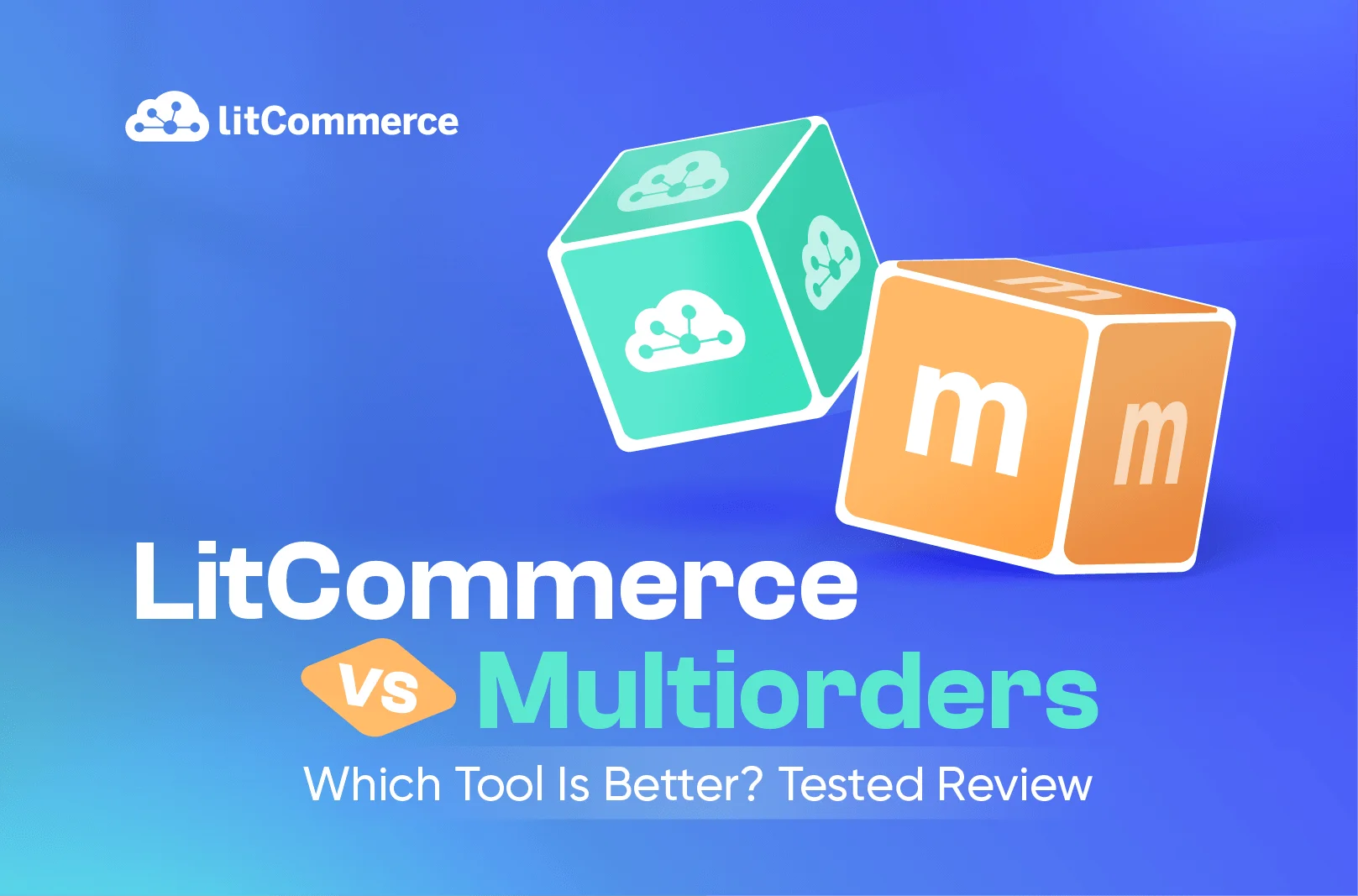LitCommerce and Multiorders are multichannel selling tools that boost your eCommerce business’s efficiency. But LitCommerce vs Multiorders? For pricing, ease of use, and features, which one is better for your business?
In short, LitCommerce covers more aspects of eCommerce, like listing, inventory, and orders with various platforms, while Multiorders focuses mainly on inventory and orders with limited supported channels. Thus, LitCommerce is the obvious choice if you want to grow your business by listing products on new marketplaces. Otherwise, pick Multiorders if you just want to simplify inventory or order management.
To provide a more comprehensive comparison between LitCommerce and Multiorders, I’ll walk you through 9 key factors:
- Channel supported
- Pricing
- Listing feature
- Pricing feature
- Inventory sync
- Order sync
- Ease of use
- Support system
- Security and policy
Without further ado, let the battle commence!
Multichannel selling made easy with LitCommerce
LitCommerce simplifies your multichannel selling with 4 simple steps: Connect – List – Sync – Manage.
LitCommerce vs Multiorders: At a Glance
Before diving into the differences between LitCommerce and Multiorders, let’s take a look at each player.
What is LitCommerce?
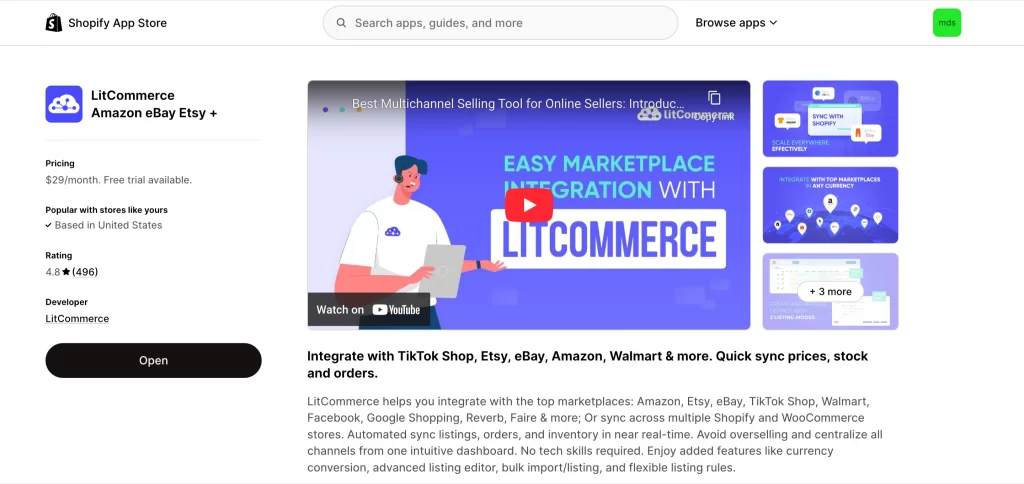
LitCommerce is a highly-rated multichannel selling tool that helps online sellers list, sync, and sell products across 20+ marketplaces and eCommerce platforms, including Amazon, eBay, Etsy, TikTok Shop, and more. Founded in 2020 and based in Vietnam, LitCommerce has quickly grown to serve over 15,000 monthly active users worldwide.
Designed with both beginners and experienced sellers in mind, LitCommerce combines powerful automation with an intuitive interface. Core features include centralized product listing, real-time inventory synchronization, and seamless order sync—helping you simplify multi-channel operations while boosting efficiency.Beyond marketplace integrations, LitCommerce also offers a Product Feed Management Tool, enabling sellers to push product data to top advertising channels like Google Shopping, Facebook, Pinterest, TikTok, and Bing. With smart category mapping, automated syncing, and built-in quality checks, it ensures your product feeds meet platform requirements and maximize visibility.
What is Multiorders?
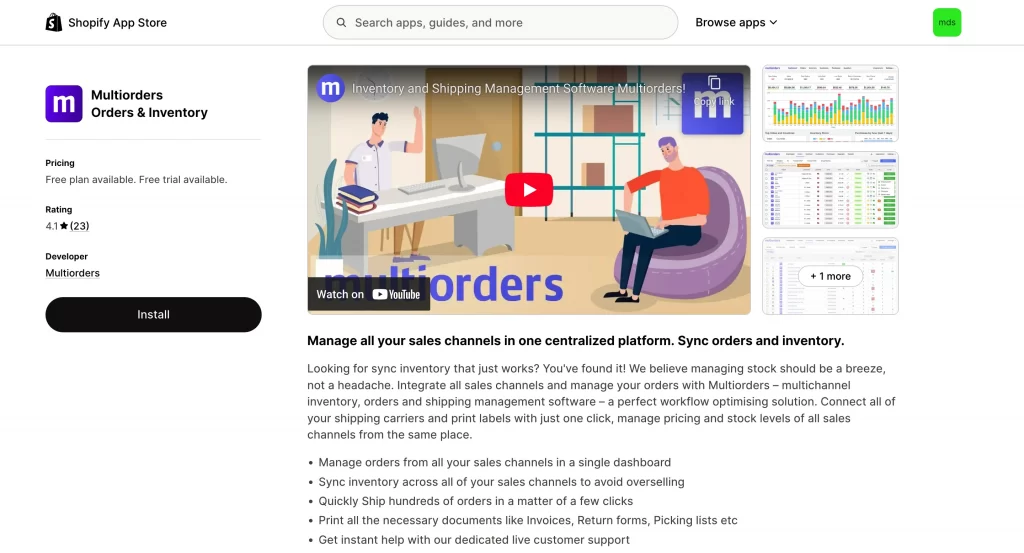
Multiorders is a multichannel selling and order management tool designed to help online merchants run their businesses more efficiently. It allows sellers to sync inventory across different sales channels, ensuring accurate stock levels and reducing the risk of overselling.
Beyond inventory control, Multiorders also supports automated order fulfillment by integrating with major shipping carriers, so you can create shipping rules, print labels, and speed up delivery from one place. In addition, the platform provides reporting features that give you insights into sales performance, helping you make better business decisions.
To sum up, both LitCommerce and Multiorders are tools designed to simplify the selling process on multiple platforms. But which one is better for multichannel selling? Let’s move to the next part: LitCommerce vs Multiorders comparison.
LitCommerce vs Multiorders – Comparing 9 Key Factors
In this article, I will use the multi-criteria decision analysis (MCDA) approach to give you the most comprehensive comparison between LitCommerce and Multiorders. This methodology will ensure that I cover every aspect you might care about while considering which tool is the best fit for your team. Want to get more details about this MCDA approach? Check out our methodology!
So, before jumping into each criterion, let’s overview the differences between 2 candidates.
LitCommerce | Multiorders | |
Channels supported | Supports various marketplaces and eCommerce platforms | Limited support covering major marketplaces and eCommerce platforms |
Pricing | Tailored based on integrated channels and listings | Based on the number of orders |
Ease of use | Modern, intuitive interface with guided setup | Functional layout with easy navigation |
Listing feature | Robust listing capabilities with bulk listing, templates, and quick grid | Developing listing features, currently supporting Wix to eBay and Etsy |
Pricing feature | Customizable pricing rules for each channel | Ability to set different prices for each channel |
Inventory feature | Real-time inventory sync with customizable rules | Inventory management with reorder alerts and warehouse-specific adjustments |
Order feature | Integrated order flow with web store fulfillment | Order and shipping automation with major carrier integrations |
Support system | Live chat, email, and comprehensive documentation | Limited support availability, with email and live chat options |
Security and policy | Privacy policies and terms of use for user data protection | |
#1. Channels supported
Let’s start by discovering which sales channels LitCommerce and Multiorders support. This is primarily a basic but most important criterion, as if that tool doesn’t support the sales channel you are selling on, it is definitely not “the one” for your business.
LitCommerce
As a multichannel selling tool, LitCommerce allows you to connect and sell on various platforms, from world-leading marketplaces like Amazon, eBay, and Etsy to trending channels like TikTok Shop.
Regarding the shopping cart platforms, LitCommerce currently supports 7 platforms:
- CSV files.
- Shopify
- WooCommerce
- Wix
- BigCommerce
- Squarespace
- Square
For marketplaces, you can use LitCommerce to integrate with the over 10 channels below:
1. Amazon
2. eBay
3. Etsy
4. TikTok Shop
5. Walmart
6. Google Merchant
7. Facebook Shop
8. Reverb
9. Shopee.
10. Temu
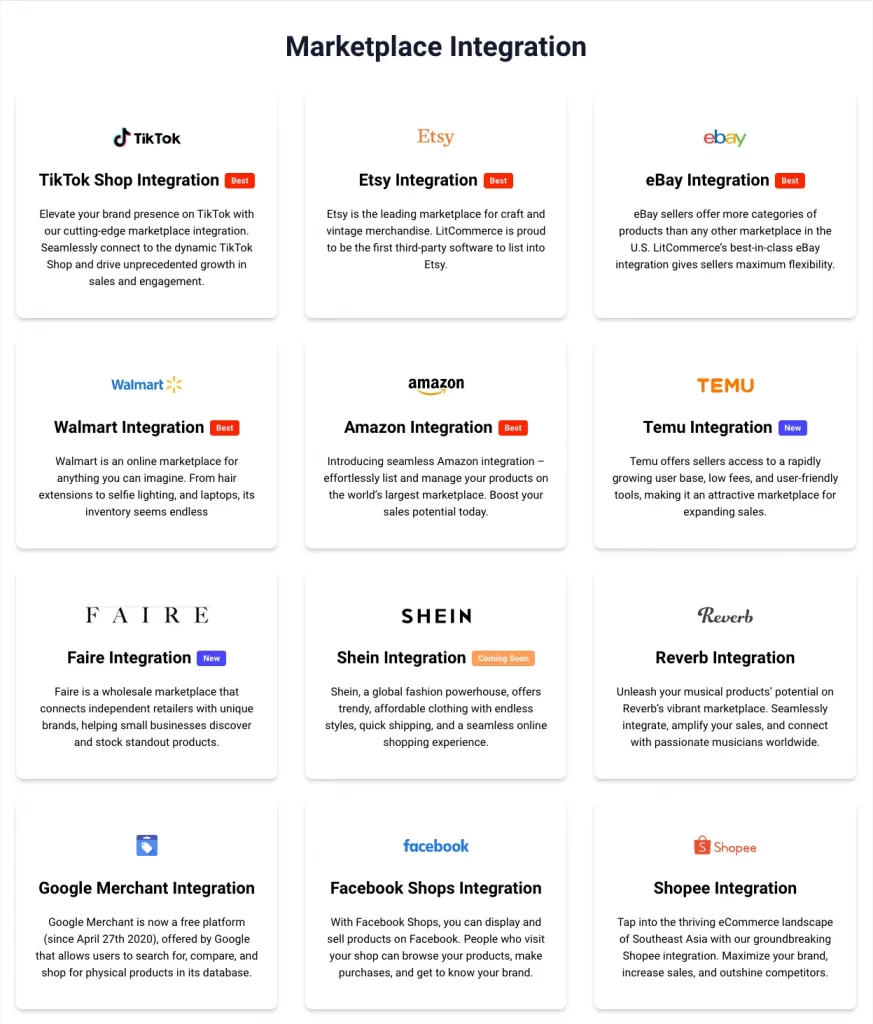
Multiorders
Unlike LitCommerce – one of the Multiorders alternatives, this tool supports limited platforms. It covers only the top-selling marketplaces and channels, including Amazon, eBay, and Etsy for the marketplaces and Shopify, WooCommerce, Wix, and BigCommerce as the shopping carts.
However, while LitCommerce doesn’t provide shipping management, Multiorders helps sellers print shipping labels from many popular carriers. They compose USPS, Royal Mail, DPD (Local/ UK), UPS, Parcel2Go, Click&Drop, DHL Express, Deutsche Post, and Canada Post.
Verdict:
LitCommerce supports more marketplaces and eCommerce platforms. Meanwhile, Multiorders helps you to work with shipping partners.
But what if both tools support the same platforms you are selling on? Which tool should you choose? Let’s consider the following factor: Pricing.
#2. Pricing
Let’s admit this. Pricing is also one of the most crucial factors when considering purchasing, just like your customers. In this second part of the LitCommerce vs Multiorders competition, I will show you how much each tool costs.
LitCommerce
In our opinion, LitCommerce offers an advantageous pricing model. Using this tool, you only pay as you go. This means that your bill is tailored depending on the number of channels you integrate and the number of listings you publish, no matter how many orders you get.
For instance, if you integrate 3 channels and publish 1000 listings, your monthly bill is $29. With 4 channels with the same number of listings, you will need to pay $34 per month. For the yearly plan, you will get 20% off, saving much more money.
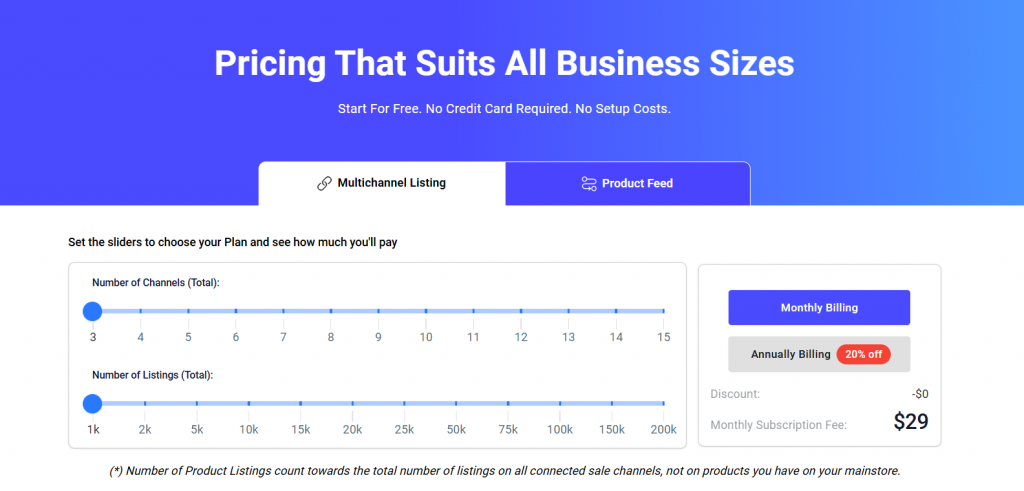
However, if you just want to try this tool, LitCommerce does offer a 7-day free trial, in which you can integrate your sales channels and try listing your products across multiple channels.
Here is the pricing of the 4 most used plans of LitCommerce:
Monthly Plan | Yearly Plan | |
3 channels + 1000 listings | $29 | $24.00/mo |
4 channels + 1000 listings | $34 | $28.00/mo |
3 channels + 2000 listings | $44 | $36.00/mo |
4 channels + 2000 listings | $49 | $40.00/mo |
Do you want to integrate more channels and more listings? Check out LitCommerce’s pricing for more details!
Multiorders
Unlike LitCommerce, the pricing model of Multiorders is built based on the number of orders you get per month with 4 fixed options below.
Plan | Number of orders | Monthly Billing | Yearly Billing |
Pro 500 | Up to 500 orders/ month | $64 | $640 |
Pro 1K | Up to 1000 orders/ month | $129 | $1290 |
Pro 2K | Up to 2000 orders/ months | $195 | $1950 |
Pro 5K | Up to 5000 orders/ month | $299 | $2990 |
So, if you want to test this tool, you can go for the Pro 50 plan until you get 500 orders.
Verdict:
LitCommerce’s price depends on the number of integrated sales channels and listings, while Multiorders’ price depends on the number of orders. However, in general, LitCommerce offers lower fees than Multiorders.
But is the tool worth paying for? Let’s move to the most important part: The features of LitCommerce and Multiorders. Checking their features can help you define if the tool can help you solve your problems.
Comparing LitCommerce with Multiorders, I will walk you through 4 main features corresponding to 4 primary operations when you sell your items on multiple channels: Listing, pricing, inventory, and order management.
#3. Listing feature
How can LitCommerce and Multiorders help you with your listing process?
LitCommerce
Manually listing hundreds of items on new sales channels can take significant time and effort. LitCommerce simplifies this process by allowing you to transfer products from your existing store to multiple marketplaces and platforms with ease.
This tool even provides 2 other features below to speed up your listing process.
- Bulk listing. Instead of manually creating a one-by-one listing, you can easily list all your items from your current store to any channel you want in bulk with just a few clicks. Multichannel listing is a piece of cake that way.
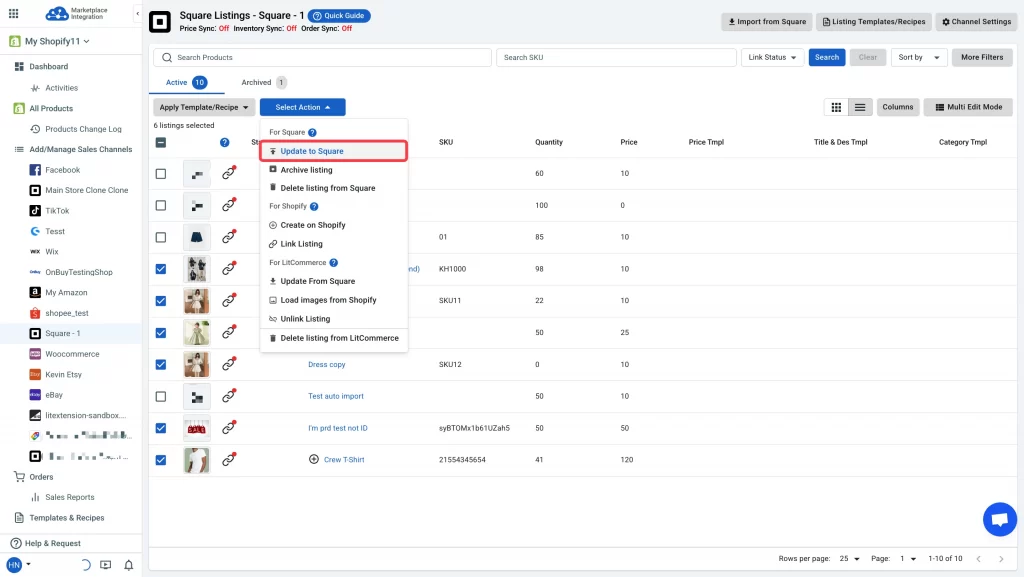
- Templates and Recipes. A template is a set of different rules and attributes for listings, such as product title, description, and shipping, while recipes are a set of different templates. These features help you quickly set rules for groups of specific products or different sales channels, saving you more time on listing for multiple channels

Multiorders
Originally, Multiorders was designed as a streamlined inventory and order management solution, and it did not support product listing capabilities. However, in 2023, the platform introduced a Beta version of Multiorders 2.0, which began adding listing functionality. Today, listing features are available, enabling sellers to transfer products from Wix stores to marketplaces like eBay and Etsy.
The current listing interface offers two modes:
- Single product edit: Ideal for modifying individual listings.
- Bulk product edit: Enables editing multiple items at once, streamlining larger listing workflows.
Verdict:
Overall, if listing efficiency and broader marketplace coverage are priorities, LitCommerce is the more comprehensive solution, while Multiorders offers only basic listing support alongside its main focus on inventory and order management.
Verdict:
When it comes to the listing feature between LitCommerce vs Multiorders, LitCommerce obviously wins over Multiorders, offering a broader range of features to support your listing process.
#4. Pricing rules
Both Multiorders and LitCommerce allow you to customize your pricing on different channels. But which tool is better? Or do they offer the same things? I will answer you right below.
LitCommerce
Regarding the pricing feature, LitCommerce allows sellers to set up pricing rules. This feature is handy because it lets you tailor your price for different channels. With LitCommerce, you can:
- Sync prices: This is simple. With LitCommerce, you can align the price of your items on your main eCommerce store with other channels.
- Use sale price: This option allows you to use the sale price (if available) for price synchronization.
- Set pricing rules: You can adjust the prices across your sales channels by percentage or a fixed price. Each marketplace has its selling fees. This feature thus ensures your profit across all your sales channels.

Multiorders
Like LitCommerce, Multiorders allows you to set the same price for all channels and specific prices for each channel. You simply need to enter your desired number to customize your price for each channel. For example, you can set $80 for your product on your Wix store but $100 on Etsy.
Although Multiorders lets you customize your price for each channel, this process is quite time-consuming and inconvenient because you need to enter the desired prices for each platform manually.

Verdict:
LitCommerce offers a more streamlined and efficient approach to pricing customization across multiple channels than Multiorders, thanks to its user-friendly pricing rules feature.
#5. Inventory feature
As you are selling across multiple platforms, the inventory feature is definitely one of your main concerns. Let’s see how Multiorders vs. LitCommerce can help sellers with the inventory management process.
LitCommerce
LitCommerce’s 15-minute inventory sync feature makes it super easy to track stock across all your sales channels in one single spot.
When an order is made in one of your stores, LitCommerce automatically updates the stock levels everywhere, preventing overselling or out-of-stock.

Moreover, you can use the inventory rules feature to customize your inventory according to the specific needs and demands of each platform. For example, you can set 50% of your inventory for your Shopify store, 30% for Amazon, and 20% for your TikTok Shop.
Additionally, LitCommerce offers a maximum quantity feature, which can create a sense of urgency by limiting the number of items available, thus boosting sales.
Multiorders
Similar to LitCommerce, Multiorders streamlines your inventory management by allowing you to sync stock levels and easily track stock from multiple warehouses with your Multiorders account. Besides, this tool also allows you to set and display your maximum and minimum quantity of products available for each channel, which also helps you create the rarity for your items.
However, LitCommerce and Multiorders differ in how they let you set your inventory on different channels. On LitCommerce, you can set inventory rules for one channel with a specific percentage of your web store inventory. For instance, your TikTok Shop takes 10% of the available inventory of your Shopify shop. Meanwhile, on Multiorders, you have only the option of displaying the same quantity for every channel or setting the maximum/ minimum quantity.
One unique feature offered by Multiorders is the Inventory Reorder point, which sends email alerts when stock levels drop below a specified threshold. This helps you stay proactive in managing your inventory and ensures you never run out of essential items. Plus, if your products are put in multiple places, you can easily change how many you have left in each warehouse.

Verdict:
LitCommerce is better suited for sellers who want advanced control and customization across channels, while Multiorders benefits sellers who prioritize stock alerts and warehouse-level management.
#6. Order management & fulfillment
When it comes to multichannel selling, the most effective way to manage and fulfill orders from all channels is to manage them from one place. Here’s the lowdown on LitCommerce and Multiorders:
LitCommerce
LitCommerce simplifies your order management with an integrated order flow. This tool can import all your orders from different sales channels to your web store. This means you can fulfill all in one place and right where you’re most comfortable without the hassle of juggling between different platforms. It’s perfect if you want to keep things straightforward and stick with what you know.
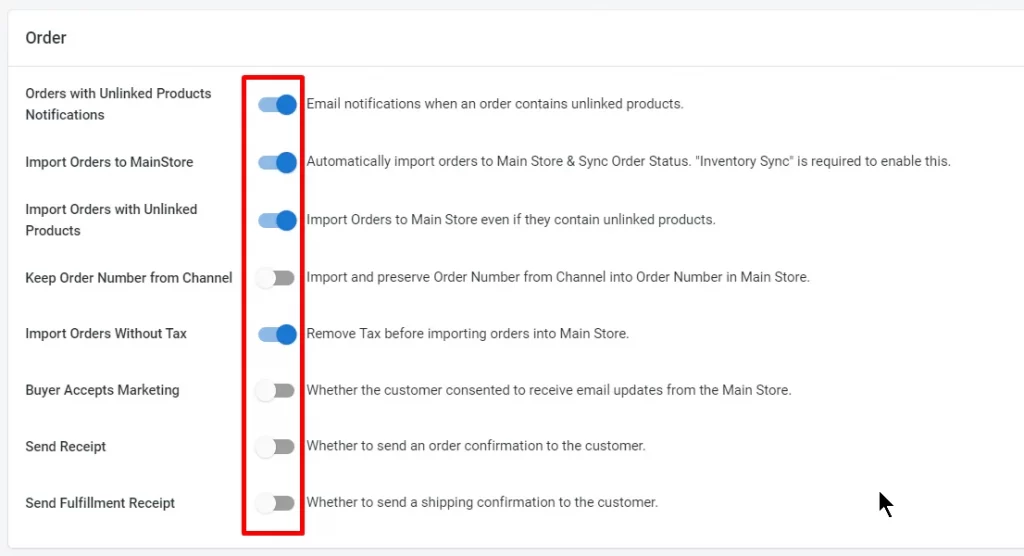
Multiorders
With LitCommerce, you handle your orders through your shopping cart, but with Multiorders, you can manage and fulfill your orders directly on this platform.
This is because, besides marketplace integration, Multiorders also supports carrier integrations, which allows you to create shipping rules and thus automate your order fulfillment process. Currently, shipping automation is available for big carriers, including USPS, FedEx, UPS, Parcelforce, DHL Express, Royal Mail, Parcelforce, DPD, DPD Local, Deutsche Post, and Canada Post.
With that step automated, the only remaining step is to print shipping labels. Still, Multiorders helps you throughout this step by letting you customize and print invoices, picking lists, delivery notes, and return forms in a few clicks.
By combining all order-related tasks into one platform, Multiorders not only simplifies your workflow but also speeds up your shipping process, keeping both you and your customers happy.
Verdict:
For sellers who value automation and end-to-end fulfillment efficiency, Multiorders holds the advantage. LitCommerce remains a solid choice for those who prefer simplicity and store-based workflows.
#7. Ease of use
The ease of use is undoubtedly a factor that should be considered in this LitCommerce vs Multiorders comparison, as you will probably work with it day in and day out. A simple and user-friendly interface will save you the effort of running your business. Let’s find out which tool is easier to use!
LitCommerce
In general, LitCommerce does a pretty good job with its usability. This tool has a modern, clean, and intuitive interface. Connecting channels is simple—you just need to select the platforms and follow the prompts. No coding skills are required, and LitCommerce provides step-by-step guides along the way.
The dashboard is straightforward, with clear sections for each sales channel, making it easy to navigate. On each channel dashboard, you can view, edit, or list the products you want without confusion. Even better, LitCommerce uses plain, marketplace-friendly language, so if you’ve sold on platforms like Amazon, eBay, or Etsy before, you’ll feel right at home. This familiar, no-frills design ensures a smooth experience for both beginners and experienced sellers.
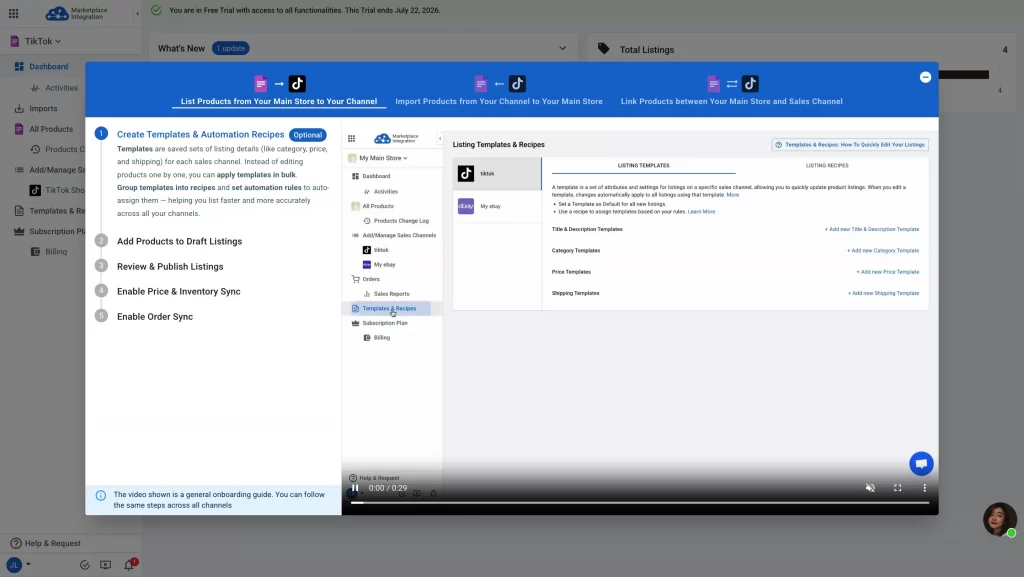
Multiorders
On the other hand, Multiorders presents a slightly different dashboard layout compared to LitCommerce. Instead of segmenting by sales channels, it divides functionalities such as orders, inventory, customers, purchases, and shipping. This arrangement allows for quick access to desired features.

Verdict:
LitCommerce and Multiorders offer user-friendly interfaces, making them accessible choices for managing your business efficiently.
#8. Support system
Multiorders and LitCommerce provide similar customer service features, but LitCommerce is available every day, while Multiorders is not. Let’s compare the customer support services of these 2 tools.
LitCommerce
LitCommerce provides multiple support channels to assist sellers. You can reach the team through:
- Live Chat: Available directly on the LitCommerce website.
- Email: Send inquiries to [email protected].
- Helpdesk: Access guides and resources via the Help Center.
- Social Media: Connect through Facebook and LinkedIn.
Support hours are:
- Monday: 04:00 AM – 12:00 AM (GMT+7)
- Tuesday – Saturday: 24/7 (GMT+7)
- Sunday: 08:00 AM – 12:00 AM (GMT+7)
For self-help, you can also explore LitCommerce Usage Docs or the LitCommerce Academy, which provide step-by-step tutorials and visual guides.

Regarding this tool’s support service, LitCommerce received many compliments for their “timely, thorough, helpful, friendly, knowledgeable” support. With impressive ratings of 4.9 stars on Trustpilot and 4.7 stars on the Shopify App, LitCommerce shines in customer satisfaction.
Multiorders
Multiorders offers similar customer support options to LiCommerce with Live Chat and Email, but they are unavailable as often. You can ask Multiorder customer support, but only from 8:00 AM to 5:00 PM GMT +1, Monday through Friday.
However, even Multiorders received compliments for its functionality, like “We use Multiorders to centralize orders and data as well to stock syncing across different platforms, which it does perfectly and in real-time.” This brand received many 1-2-star ratings for its not-that-good customer support. “Customer support made countless promises to resolve it but never did. Waiting for over a month in good faith only to get ignored.”
Verdict:
When it comes to customer support, LitCommerce is the top choice. They excel at helping customers and have received lots of praise from happy users.
#9. Security and policy
The last piece of the puzzle. Let’s look at the security and policy of LitCommerce and Multiorders. In general, both these players are dedicated to ensuring the highest level of security. Let’s delve into their respective practices:
LitCommerce
LitCommerce declares that “all the information collected on our website will be kept strictly confidential and will not be sold, reused, rented, disclosed, or loaned,” ensuring the rights of its users. You can learn more about their security measures through their Privacy Policy, GDPR Compliance, and Data Security Policy.
- Privacy Policy: This policy clearly outlines what data is collected, how it’s used, and who it’s shared with.
- GDPR Compliance: Demonstrates commitment to meeting the requirements of the General Data Protection Regulation (GDPR) for users in the European Economic Area (EEA).
- Data Security Policy: Details measures such as data encryption, access controls, and incident response procedures.
Multiorders
Similar to LitCommerce, Multiorders is committed to protecting the privacy of its users. For more insights into their practices, you can review their Terms of Use and Privacy Policy
- Terms of use: This legal document outlines all the terms and conditions that govern our relationship with their clients and others who interact with their website and tool.
- Privacy Policy: Multiorders provides transparency on data collection, use, and sharing practices.
Verdict:
Both LitCommerce and MultiOrders prioritize data security by employing encryption for data at rest and in transit.
LitCommerce vs MultiOrders – FAQs
The key differences between LitCommerce and Multiorders lie in their functionalities. LitCommerce offers features like bulk listing, customizable templates for listings, and a QuickGrid interface for efficient listing management. In contrast, MultiOrders focuses solely on inventory management and order processing and lacks specific listing functionalities. Yes, LitCommerce offers unique features such as bulk listing, customizable Templates and Recipes for listings, and the QuickGrid interface, which Multiorders does not provide. Multichannel listing is adding and managing listings across multiple sales channels. LitCommerce allows you to connect, list, sync, and sell your products across multiple channels, including eCommerce platforms like Shopify and WooCommerce or top marketplaces like Amazon, Etsy, eBay, TikTok Shop, etc.
LitCommerce vs Multiorders: Which One Is Better?
In summary, choosing between LitCommerce and Multiorders depends on your business needs. Multiorders is a solid option if your main focus is inventory and order management.
However, LitCommerce may be a better fit for sellers looking to expand across more channels, manage listings alongside inventory and orders, and benefit from strong user feedback. Its broader marketplace support and focus on multichannel growth make it a compelling option for those aiming to scale efficiently.

